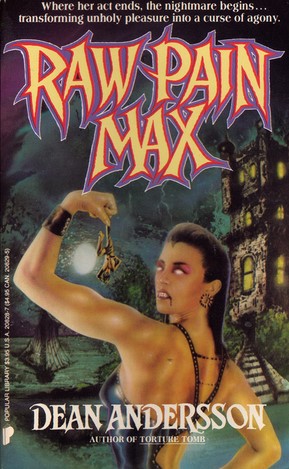 By C. DEAN ANDERSSON (Popular Library; 1988)
By C. DEAN ANDERSSON (Popular Library; 1988)
This novel represents all we’re not supposed to like about the splatterpunk movement: it’s trashy, adrenaline-fueled, misogynistic and ultimately pointless, handily encapsulating novelist Lucius Shephard’s categorization of the cycle: “Most of this crap is written for and by people with language skills comparable to those of Big Bird, and I believe that even the best of it…serves not to illuminate but to numb, to make us less sensitive to the appalling decline and terror of contemporary life.” This in itself shouldn’t be taken as a put-down, certainly not from me, a passionate fan of the gorefests of Lucio Fulci. That’s not to say, however, that the present book is particularly good.
RAW PAIN MAX is said to be Andersson’s most extreme book. I was first drawn to it by the Amazon.com customer comments about TORTURE TOMB, an earlier Andersson book, which dismissed it as “Violent porn disguised as a horror novel” and advised prospective readers to “Buy this book only if you’re too cheap to own a VCR or DVD player and rent porn. If you do, seek psychiatric help. You need it”. (Presumably the author of those sentiments has bought and read the book in question, so I hope he/she has sought the psychiatric help demanded of us!) For me there’s no greater incentive to tracking down a book than the rantings of self-righteous assholes telling me not to read it and demanding I seek psychiatric help if I do. But an ever greater incentive was in the same customer’s comments about Andersson’s RAW PAIN MAX, which was apparently similar to TORTURE TOMB, but on “ten times the sadistic testosterone and one hundred times the blood and gore.” Needless to add, I tracked down both books immediately.
RAW PAIN MAX had potential, I’ll say that much. Trudy, its punked-out, muscle-bound protagonist, spends her nights performing in a sex club under the name Raw Pain Max, which provides a perfect outlet for her deep-seated masochistic urges. But there’s trouble on the horizon, in a reincarnation-tinged narrative so insanely convoluted it probably can’t be properly summarized in anything less than novella form (it involves someone named Demon Young, an otherworldly presence known as The Ally, and godlike entities called Pain Eaters). Trudy is somehow contacted by Erzebet Bathory, the Hungarian countess who murdered countless virgins and then bathed in their blood in an apparent attempt at achieving immortality.
The novel’s primary reasons for existence are the plentiful S&M flavored torture sequences, in which people (usually women, of course) are tied up, gagged and suffer various genital mutilations (representative chapter titles include “Blood and Barbed Wire” and “Sewing Lesson”). None of it is particularly disturbing, however, simply because Andersson’s vocabulary is too limited to do his nasty descriptions justice. How many times can the word “pain” be used before it loses its power? “Soul” is another word Andersson over-uses to (and beyond) the point of annoyance (often in hyphenated conjunctions like “Soul-searing”, “Soul-penetrating”, etc.). An interesting choice, considering that the book’s spiritual content is pretty much nil, as exemplified by a passage in which the protagonist’s boyfriend tries to read a Bible and gives up, deciding to watch an old movie on TV instead. I’ll confess that, while reading this book, I often had the same idea!
